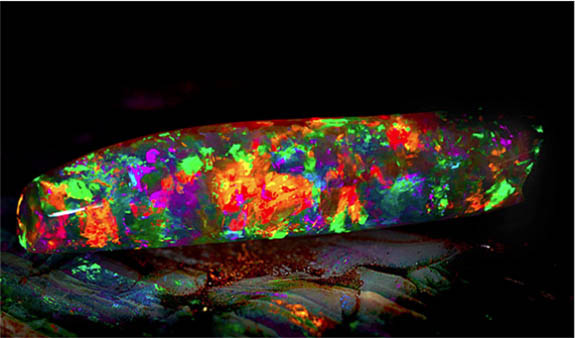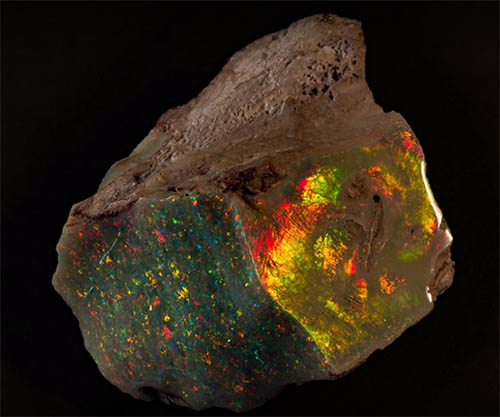May 22nd, 2017
Two of world's finest opals — the Virgin Rainbow and the Fire of Australia — are jetting 7,000 miles from Adelaide to Doha to headline a three-week special exhibition at the Australian Embassy in Qatar. This will be the first time the gems have been seen outside of Australia.

Valued at more than $1 million combined, the famous pair will join 60 others selected from the South Australian Museum’s wildly popular "Opals" exhibition, which ended its run in 2016. The Doha exhibition will be open to the public from May 24 through June 15, 2017.
South Australian Museum Director Brian Oldman noted that he was thrilled to share the finest examples of Australia’s national gemstone with the people of Qatar.

“The Virgin Rainbow is the finest crystal opal specimen ever unearthed,” he said. "It has only been on public display once before, and will provide visitors to the exhibition with an unmatched spectacle of color and beauty.”
Measuring 2.4 inches long and displaying a full spectrum of brilliant color, the finger-shaped specimen seems to have a light source all its own.
“It’s almost as if there’s a fire in there,” Oldman had told AFP in 2015. “You see all different colors. As the light changes, the opal itself changes. It’s quite an amazing trick of nature.”

The 4,990-carat Fire of Australia is acknowledged as the world’s most valuable piece of rough opal. The opal was purchased for AU$500,000 ($372,000) through the generosity of a private donor and funding from the Australian government’s National Cultural Heritage Account. Two faces of the Fire of Australia have been polished to reveal the magical colorations inside, transitioning from green to yellow to red, depending on the angle from which it is viewed.
Scientists claim that between 97 million and 100 million years ago, Australia’s vast inland sea, which was populated by marine dinosaurs, began retreating. As the sea regressed, a rare episode of acidic weather was taking place, exposing pyrite minerals and releasing sulphuric acid. As the surface of the basin dried further and cracked, silica-rich gel became trapped in the veins of the rock. Over time, the silica solidified to form opals.
Today, Australia produces more than 90% of the world’s precious opals.
The exhibition reflects a growing relationship between Australia and Qatar, which saw the commencement of Qatar Airways' direct flights to Adelaide in 2016.
Photo of Virgin Rainbow opal by Richard Lyons, courtesy of South Australian Museum. Photo of Fire of Australia opal via Facebook.com/SouthAustralianMuseum.

Valued at more than $1 million combined, the famous pair will join 60 others selected from the South Australian Museum’s wildly popular "Opals" exhibition, which ended its run in 2016. The Doha exhibition will be open to the public from May 24 through June 15, 2017.
South Australian Museum Director Brian Oldman noted that he was thrilled to share the finest examples of Australia’s national gemstone with the people of Qatar.

“The Virgin Rainbow is the finest crystal opal specimen ever unearthed,” he said. "It has only been on public display once before, and will provide visitors to the exhibition with an unmatched spectacle of color and beauty.”
Measuring 2.4 inches long and displaying a full spectrum of brilliant color, the finger-shaped specimen seems to have a light source all its own.
“It’s almost as if there’s a fire in there,” Oldman had told AFP in 2015. “You see all different colors. As the light changes, the opal itself changes. It’s quite an amazing trick of nature.”

The 4,990-carat Fire of Australia is acknowledged as the world’s most valuable piece of rough opal. The opal was purchased for AU$500,000 ($372,000) through the generosity of a private donor and funding from the Australian government’s National Cultural Heritage Account. Two faces of the Fire of Australia have been polished to reveal the magical colorations inside, transitioning from green to yellow to red, depending on the angle from which it is viewed.
Scientists claim that between 97 million and 100 million years ago, Australia’s vast inland sea, which was populated by marine dinosaurs, began retreating. As the sea regressed, a rare episode of acidic weather was taking place, exposing pyrite minerals and releasing sulphuric acid. As the surface of the basin dried further and cracked, silica-rich gel became trapped in the veins of the rock. Over time, the silica solidified to form opals.
Today, Australia produces more than 90% of the world’s precious opals.
The exhibition reflects a growing relationship between Australia and Qatar, which saw the commencement of Qatar Airways' direct flights to Adelaide in 2016.
Photo of Virgin Rainbow opal by Richard Lyons, courtesy of South Australian Museum. Photo of Fire of Australia opal via Facebook.com/SouthAustralianMuseum.


